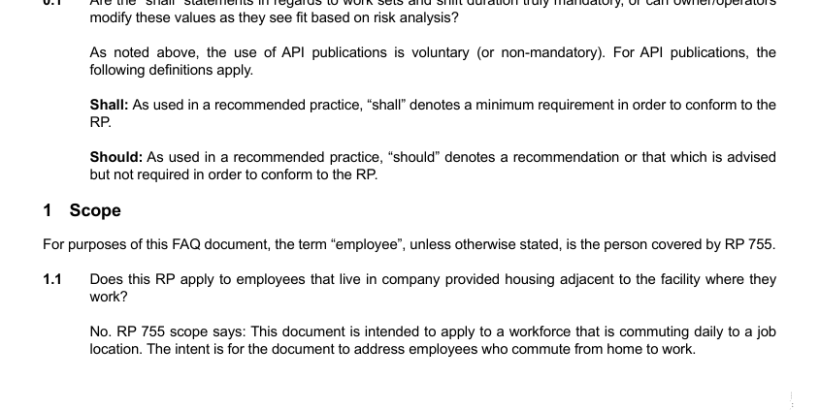API 755-2:2016 pdf free download.Frequently Asked Questions (FAQ) Document for ANSI/API RP 755, Fatigue Risk Management Systems for Personnel in the Refining and Petrochemical Industries
3.7.2 In the event of an outage, who will be considered affected?
Anyone working in units whose work schedule is impacted by the outage, as determined by management.
3.7.3 Why are more consecutive shifts allowed in an outage than in normal operations?
The Hours of Service limits recognize the need to appropriately manage business activities, especially in abnormal situations, which is why additional flexibility is allowed in an outage. Outages take place for limited periods of time and generally are not routine operations. Employees usually work fixed shifts during outages and minimize their non-work family and social commitments, and thus have more opportunity to adapt their sleep schedules. (See TR 775-1 for further information.)
3.9 Work Sets
3.9.1 Can a work set be one shift? Yes. A work set is defined as consecutive shifts with a minimum of 36 hours off before starting another work set. Therefore, if one works a single shift prior to 36 consecutive hours off, the work set is one shift.
4.1 Roles and Responsibilities
4.1.1 Why are employees responsible for being aware of their own fatigue since research indicates the individual is the least likely to recognize fatigue?
API RP 755 states that, “everyone has a role in recognizing the importance of workplace fatigue risk mitigation and actively working to support the goals of the FRMS.” Companies provide training to employees to help them proactively manage fatigue and, through the Hours of Service guidelines, provides the opportunity for adequate sleep. However, only the employee knows whether the rest obtained during the time away from the workplace was adequate. To supplement self-awareness of fatigue, the FRMS also provides for the training of supervisors to recognize the signs and mitigate the fatigue risk. However, the employee is ultimately responsible for securing adequate sleep during non-working hours.
4.1.2 How should a supervisor respond when an employee expresses concerns about being fatigued? Similar to other fitness-to-work situations, concerns regarding employee fatigue should be evaluated on a case by case basis to determine the appropriate course of action. For example, supervisors may address fatigue by recommending actions to enhance alertness, sending an employee home, or referring an employee to medical services. Persistent patterns of fatigue may be addressed through performance management and/ or referral to resources that can assist the employee address the root causes.
4.2 Positions Covered by the Fatigue Risk Management System
4.2.1 RP 755 mentions that the guidelines are intended for “employees working night shifts, rotating shifts, extended hours/days, or call outs involved in process safety sensitive actions.” Do the guidelines apply to straight day shift employees?
According to RP 755, straight day shift employees are not subject to night shifts or shift rotations that increase the likelihood of fatigue, so the hours of service limits do not apply unless they are subject to extended hours or call outs. However, site-specific FRMS plans may choose to include limits such as applying the outage hours of service limits to such employees, particularly if they are engaged in process safety-sensitive positions.
4.2.2 How are individuals that work both covered and uncovered positions addressed under the standard?
If an individual works both covered and uncovered positions during their work set, all hours/days worked during the current work set and the work limitations will apply at the time they are working in a covered position. For example, if an individual works as instrument mechanic (covered position) and then he is stepped up to a contractor coordinator (non-covered position) during the same work set without a rest period, then the individual would not have a limit on the number of consecutive days if he stayed in this non-covered position. If the individual moves back to a covered position and has exceeded the consecutive day limitations, then he would require a rest period before returning to the covered position.API 755-2 pdf download.API 755-2:2016 pdf free download
